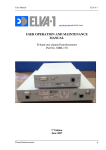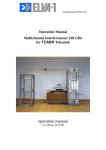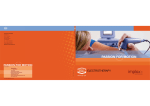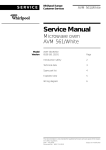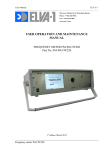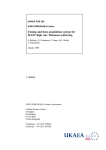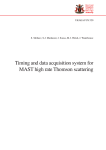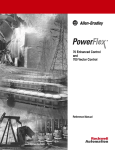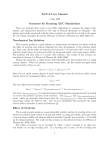Download 140 GHz one channel Interferometer - ELVA-1
Transcript
User Manual ELVA-1 www.elva-1.com [email protected] USER OPERATION AND MAINTENANCE MANUAL D-band one channel Interferometer Part No. MMI-140R2 2013 D-band Interferometer 0 User Manual ELVA-1 Table of Contents. 1. Introduction. 1.1 General Description. 2. Specifications. 2.1 Electrical. 2.2 Mechanical. 2.3 Block-diagram of interferometer 2.4 Principle of operation 3. Installation and Functional Tests. 3.1 Assembly procedure. 3.2 Test and tuning procedure. 4. Measurements. 4.1 Put into operation 4.2 Measurements. 4.3 View and Save data. 4.4 Software tools. 5. Test report. 5.1 Output Power 5.2 Operation Frequency. 5.3 AGC signal. 5.4 Accuracy of measurement. 5.5 Test measurement of real time signal D-band Interferometer 1 User Manual ELVA-1 1. INTRODUCTION. This instruction manual contains information on installation and operation of the D-band Interferometer. 1.1 General Description. D-band interferometer is intended for measuring the line-averaged density of a plasma along the path through which the mm-wave beam is passed, through phase shifts in the propagated beam. Base principle of operation is an effect of change of phase speed of electromagnetic waves of a millimeter range in plasma depending on density. D-band Interferometer 2 User Manual ELVA-1 2. SPECIFICATIONS. 2.1 Electrical Specifications. 1. RF Frequency 2. LO Frequency 3. Frequency Stability 4. Time Phase Analyze 5. Time collection 6. Phase error measurement 7. Data rate of real time density 8. Real time density interface 9. Real time signal rate 10. Output RF Power 11. Max attenuation Tx-Rx 12. IQ Detector Frequency 13. RF to IF Gain 14. Conversion Loss of Mixer 15. Noise Figure 16. Gain of Horn 17. Waveguide 18. Flange 19. Data interface 20. External trigger 21. Input impedance of trigger input 22. Waveguide transition 23. AC Power 24. Operating temperature range: 140.0 GHz; 138.0 GHz; 10 ppm; 5 µs; 1000 ms; 0.07 radian; 10kHz voltage, +0.1 … +5.0V 15.4 Rad/V 100 mW; > 90dB 100 kHz; 70 dB with AGC system; 9 dB; 12 dB; 30 dB; WR-06 UG-387/U-M TCP/IP Ethernet; TTL; 50 Ohm; WR-06 to WR-42; 220 VAC (external modules) +10°C…+ 50°C; 2.2 Mechanical Specifications. 1. Transmitter 2. Receiver D-band Interferometer 300x205x70 mm; 250x235x70 mm; 3 User Manual ELVA-1 2.3 Block-diagram of the interferometer. DRO 7.0 GHz Coupler Doubler IMPATT Multiplier x10 BPF 140 GHz TRANSMITTER 7 GHz out SMA ILA 140 GHz Horn TOKAMAK Horn RECEIVER VCO 6.9 GHz 7 GHz in SMA Coupler Doubler IMPATT Multiplier x10 BPF 138.0 GHz Balance Mixer Balance Mixer LNA 2.0 GHz IF=100 MHz Phase Detector PA with AGC Reference Crystal Oscillator 100 MHz Synthesizer 2.00010 GHz Sin / Cos, AGC signal, 4 pins connector TCP/IP interface, RJ-45 Controller TCP/IP IQ Detector 100 kHz Controller With ADC Controller Real Time Density signal TTL, External trigger, Opto-isolated, BNC D-band Interferometer 4 User Manual ELVA-1 2. 4 Principle of operation. The interferometer operates at fixed frequency. Due to all built-in oscillators are phaselocked by one reference Cristal oscillator 100 MHz, there is a possibility to control phase shift of mm-wave signal is passed through plasma. Mm-wave oscillators (transmitter and LO for receiver) are built on one principle. The transmitter consists of ultra low phase noise DRO 7.0 GHz, direction coupler 1:10, doubler and multiplier x10 with integrated high power amplifier at 14 GHz. The direction coupler provides 7.0 GHz signal for receiver. The transmitter generates output frequency at 140.00 GHz, 7.0 GHz x20. The mm-wave receiver consists of VCO 6.9 GHz, direction coupler 1:10, doubler, multiplier x10 with integrated high power amplifier at 14 GHz and balance mixer. For stabilization IF signal and phase-locking LO frequency, the signal 7.0 GHz from transmitter is used. After down conversion the signal from transmitter we have IF frequency 2.0 GHz. Then this signal is amplified by LNA and comes to power amplifier with built-in AGC system. AGC system allows to keep stable amplitude of IF signal in 30-70 dB attenuation range in mm-wave channel. Response time of AGC system is 2.5 microsec. Then stabilized IF signal is applied to IQ mixer, where as LO oscillator synthesizer 2.00010 GHz is used. The synthesizer 2.000010 GHz is also phase-locked by reference Cristal oscillator 100 MHz. IQ mixer provides two IF signals 100 kHz (sin and cos), which are digitized by built-in 12 bits ADCs. The controller converts digital data in Ethernet pockets and transfers them via TC/IP interface to PC station. PC station collects data from the interferometer and calculates absolute phase changing during discharge of plasma. The software operates the following way: as 100 kHz signals and trigger of ADC converters are locked by one reference, we can control only pass zero points of IF signals without any additional reference signal, i.e. relation between period of IF signal and quantity of digitized points inside of this period is constant in anytime (without plasma). Such way we get absolute rate Pi / (digitized points) φo and can control phase shift of signal during discharge of plasma. As we have two 100 kHz signals from IQ detector (sin and cos) total pass zero points is four times more and finally time phase analyze is 2.5 microsec. The software calculates time different between close pass zero points and compare it with absolute rate. Then sum different between actual and absolute rate: 0 ∑ (ϕ (n) − ϕ (n − 1) ) N Where, n - number of current pass zero point from the beginning of discharge. N – total quantity pass zero points during of discharge After collection data and calculation total drift of phase the software recalculate phase in absolute changing of density of plasma with rate 0.4143*10^(18) / m^3 (operation frequency 140GHz, diameter of plasma 0.4m) D-band Interferometer 5 User Manual ELVA-1 3. INSTALLATION AND FUNCTIONAL TEST. 3. 1. Assembly procedure. The interferometer can be installed directly near windows of TAKAMAK or removed from it by extension WR-42 waveguides, as it presented on picture below. D-band Interferometer 6 User Manual ELVA-1 Waveguide’s set of the interferometer consists of the following components: - Waveguide transition WR-06/ UG-387/U-M to WR-42 / UG-595/U - Horns WR-06/ UG-387/U-M D-band Interferometer 7 User Manual ELVA-1 After setting waveguides the following connection according block-diagram of the interferometer should be done: Transmitter output Receiver input 1 2 3 D-band Interferometer 4 5 6 8 User Manual ELVA-1 1. 7 GHz reference signal from the transmitter (1) to receiver by coaxial cable with SMA connectors. The system is completed 2 cables, one is spare. 2. Power supplies via applied cables with DB-9 connectors. Power supplies are equal and can be used any for transmitter and receiver. D-band Interferometer 9 User Manual 3. ELVA-1 Receiver to PC station by TP5 cable with RJ-45 connector. 4. Special cable for control IF signals 100 kHz and AGC signal. 5. BNC input for external trigger TTL pulse 6. SMA output ‘Real time density’, 0 …+5V Connect all BNC connectors any oscilloscope for control 100 kHz IF signals and AGC. When all connections are done, complete PC station with standard monitor, keyboard and mouse and switch ON all power supplies and PC. D-band Interferometer 10 User Manual ELVA-1 3. 2. Test and tuning procedure. Before installation the system on TOKAMAK it can be tasted on table. Assemble the system as disrobed above and place Tx/Rx modules as presented on picture below: Then run program ‘Interferometer’ (placed on desktop), the main menu of program appears: For test IF signals 100kHz and AGC signal test mode should be run, press button ‘Test’ and real time oscilloscope window with 100 kHz IQ signals appears D-band Interferometer 11 User Manual ELVA-1 For test trigger operation Measure mode should be run, press button ‘Measure’ and new sub-menu is appearing: then press button Measure in sub menu for waiting a trigger pulse. Enter discharge No and select folder for saving data. Apply trigger pulse (or make short cut) to BNC connector (5). After collection of data come back to main menu (press Close) and then select View mode. Select file with set before discharge No and open it, after that measured result is appeared. Picture below demonstrates correct operation of the system. D-band Interferometer 12 User Manual ELVA-1 After passing ‘table test’ the system can be installed on TOKAMAK. Assemble and adjust complete system and before starting to work the user has to test and tuning horns (if it is needed). For that the user should switch on system in Test mode and check form of IF signals and level of AGC system. To control sinusoidal wave form of IQ signals and AGC signal tune horns such way to get minimum available level of AGC signal. Below dependence of AGC signal vs attenuation in waveguide channel is presented. For reference, total attenuation in assembling system with installed horns in open area should be about 60 dB, that corresponds to about +2.95V output of AGC signal. After tuning procedure the user should test trigger operation of system as it was described above. D-band Interferometer 13 User Manual ELVA-1 4. MEASUREMENTS. 4. 1. Put into operation. 1. Connect cable with trigger signal from TOKAMAK control system to opto-isolated BNC connector (5) on the receiver. The trigger pulse should be TTL standard and has duration no less then 1 ms. The interferometer starts to collect data with rise front of the trigger pulse. 2. Run software and put into menu ‘Measure’ 3. Enter discharge serial No (1) and select folder (2) for saving data and then press Measure (3) for regime ‘waiting a trigger’ 1 2 3 4. The system is ready for measurement. D-band Interferometer 14 User Manual ELVA-1 4. 2. Measurements. After start up procedure the system is waiting for trigger. When trigger pulse is appeared software automatically save raw data into selected folder, add ‘+1’ to discharge serial No and then comes back into regime ‘waiting for trigger’. To stop circle of collection data, press button Close. 129+1 5. Software generates file name with real time indication: 00129_20130912_173640.ifr where, discharge No_year_moth_day_hour_min_sec The file structure is: N = 2500000 0 26536 -15012 1 22352 -21668 2 16776 -26408 3 10132 -29120 4 2908 -29928 ……….. Where, N – quantity of measurements No of measurement _ ADC 16 bits code I channel _ ADC 16 bits code Q channel D-band Interferometer 15 User Manual ELVA-1 4. 3. View and Save data. To view saved data come to main menu or run one more Interferometer software and then press button View. Selection file window is appeared. Select file and press open, when software recalculates raw data and draw result. 1 D-band Interferometer 16 User Manual ELVA-1 User can switch On/Off presented data to use flags into window No1. Below is example with measured data only. 2 The result of measurement can be presented as a phase shift in radians (Y-axis is graduated in radians) or electron density (Y-axis is graduated in *10^(18) / m^3). To see result in radians in window No2 ‘1.000’ should be entered (picture above) and ‘0.4143’, as presented below 2 D-band Interferometer 17 User Manual ELVA-1 There is possibility to install markers at measured dada. For that press marker list, activate flag ‘add markers’ (window No3) and then select desired point by using PC mouse tool. 3 To save data as image in bmp format, press ‘Export image’, enter file mane and select folder for saving. D-band Interferometer 18 User Manual ELVA-1 To save final data in txt format press ‘Export data’, enter file mane and select folder for saving. Software stores data in file ‘xxxx.ifd’ After proceeding data, press button ‘Close’ and save menu appears , press button ‘Receive data’ and then wait trigger pulse. Message “Data received’ appears when data is collected and available for viewing and saving To save data press button ‘Save data’, for viewing “View data’: 4. 4. Software tools. Set limits for axis Present data in min to max data scale X-axis Y-axis X and Y axis Zoom buttons Button to set scroll sensitivity D-band Interferometer 19 User Manual ELVA-1 5. FUNCTIONAL TESTS. 5. 1. Output power. Test setup in presented below. Transmitter Power sensor Power sensor Indicator Measured data: Pout = 104.4 mW . D-band Interferometer 20 User Manual ELVA-1 5.2. Operation frequency. Test setup in presented below. Horn Horn Transmitter Frequency Meter 1m Measured data: Fout = 140,004271 GHz D-band Interferometer 21 User Manual ELVA-1 5.3. AGC signal. Test setup in presented below. Transmitter 10dB Direction Coupler 10dB Direction Coupler Direct reading Variable attenuator 0 – 70dB Receiver Volt Meter AGC signal Test data is presented on plat below. D-band Interferometer 22 User Manual ELVA-1 5.4. Accuracy measurement. Test setup in presented below Direct reading 10dB Variable attenuator Direction Coupler 0 – 70dB Horn Horn Transmitter PC 1.5m Receiver Measured data: Accuracy measurement is < 0.07 radians D-band Interferometer 23 User Manual ELVA-1 5.5 Test Measurement of real time signal Test setup in presented below MicroMeter Electromagnetic solenoid Transmitter PC Receiver Coil spring Movable metal reflector Power supply Trigger Oscillator Oscilloscope Principle of operation – apply voltage to electromagnetic solenoid and move reflector. Coil spring returns reflector in initial position. Micrometer check actual shift of reflector. Trigger oscillator provides pulse for apply voltage to solenoid and run the system. D-band Interferometer 24 User Manual ELVA-1 Measured data Micrometer: 8.8mm, that corresponds to 8.8 / 2.14 (wave length for 140GHz) *6.28 =25.8 rad Real time signal on the oscilloscope: dU=1,684V, that corresponds 1,684V *15,4 Rad/V= 25,93 rad The system measured 25.97 rad D-band Interferometer 25


























